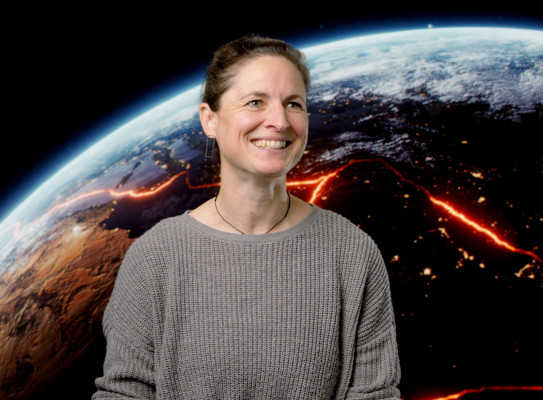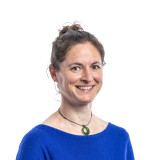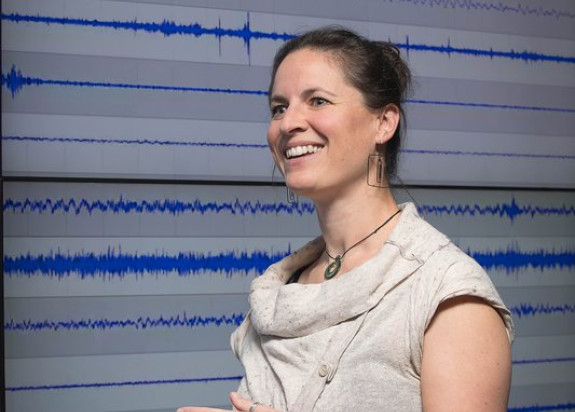Seismologist Jen Andrews shares her science journey

Join us as we celebrate International Women's Day and interview GNS Seismologist Jen Andrews.
She takes us on a journey into her science career, from childhood curiosity sparked by outdoor exploration to her current role monitoring and characterising earthquakes at GNS Science.
International Women’s Day (IWD) is celebrated globally on 8 March each year. It’s a day dedicated to recognising the social, economic, cultural, and political achievements of women worldwide.
Although women make up half the world’s population, they remain significantly underrepresented in science, technology, engineering, and mathematics fields. According to UNESCO, only around 30% of researchers worldwide are women. However, efforts to promote gender diversity and inclusion in these fields are ongoing, aiming to ensure that women have equal opportunities and representation in science-related careers. According to the World Economic Forum the growth of women in STEM roles has increased incrementally since 2015, outpacing the growth of women in non-STEM roles.
Jen’s Q&A reflects on the importance of finding one’s passion and overcoming the challenges as a woman in science, and the significance of IWD in celebrating achievements and making progress towards gender equality.
Q&A with Jen Andrews
Can you remember a specific moment when you were young that sparked your love of science?
I remember always wanting to know the why and the how of things as a kid, especially in school, but it never occurred to ask those questions about rocks and mountains too. We were always an outdoor family and one day a friend started to wonder how some particular boulders had ended up where they were, and for the first time, I thought how amazing it would be to understand the story of the landscape around me.

What science subjects interested you as a student?
My school only offered the core science subjects: physics, chemistry, and biology. I enjoyed physics the most, with its exotic topics like quarks and time distortion. However, studying physics at university was much more about the fundamentals in the first year. I quickly realised I wanted something more varied and more applied. That’s what led me to switch to earth sciences. The mixture of classroom, lab and fieldwork suited me perfectly, and that taught me the importance of finding the things you enjoy and not being afraid to change course.
What was your first science job?
My first role out of university was as a geophysicist based in the UK, working in a company that specialised in monitoring very, very small earthquakes. I loved the diversity of the work I was doing, from sitting in a truck at a reservoir somewhere around the world monitoring real-time earthquake activity, to developing software, or teaching classes how to use it. The company was a small, supportive team, and it gave me the opportunity to focus on the skills I wanted to develop.
When did you start working at GNS Science, and in what role? What do you do now?
I’ve been at GNS for about two years now, and I work as a seismologist. I really enjoy the more applied topics that have a tangible real-world impact. My work over the past decade has focused on the real-time monitoring and characterisation of earthquakes, developing tools and skills that will help when destructive events occur. This also means that I’m usually not only thinking about the science of earthquakes but also how people respond and what they need during and after an event.
What would you say are the perceptions of women and girls in the science research sector?
For me, earth science has always seemed to have an exceptionally good representation of women and girls. From the nearly equal gender mix on my university course to the inspiring, highly respected and highly visible seismologists in the places I’ve studied and worked. I think the only disappointing thing I’ve noted is the low proportion of women leading high-profile projects while making up the majority of the slightly lower tier roles where a lot of the hard work gets done. I’m hoping that’s just a reflection of a changing trend through time though and we’ll begin to see more women move into those senior roles.
Have you ever felt under-represented in a room full of scientists?
While I’ve generally seen a fairly good representation of women in seismology, I’ve definitely had the experience of being the only woman in the room. Especially in certain contexts such as reservoir engineering or software development. Most of the time though, once the room is focused on the technical topics, it hasn’t been an issue and that’s what I always try to remember.

Do you have any advice for women and girls interested in a future in science and research?
Science is such an exciting, broad, and rewarding career that I always encourage anyone with an interest to keep following their passion. Being a woman or girl in the field shouldn’t be any kind of barrier. One thing I realised a little late, but really value now, is the importance of having a community of women in the field and supporting and encouraging each other.
Lastly, what does International Women's Day mean to you?
For me, International Women’s Day is a great moment to recognise and celebrate all the amazing women who have inspired and encouraged me. This includes early pioneers like Inge Lehmann (who discovered the Earth’s inner core) and so many mentors, colleagues and friends around the world. It’s also an opportunity to remember that we live in a constantly shifting world, and we can all be a part of the changes.